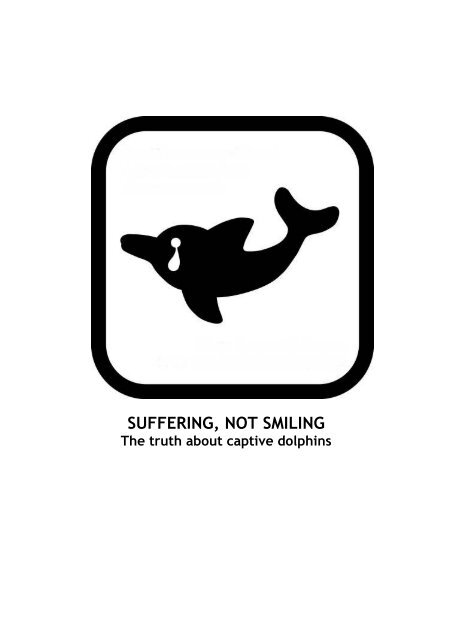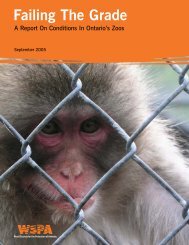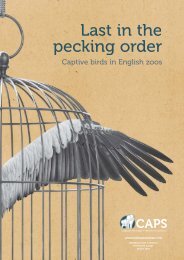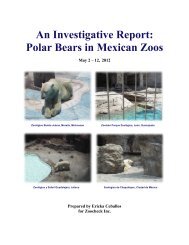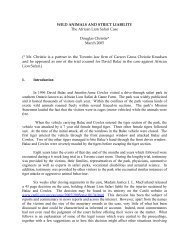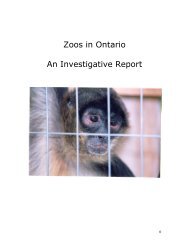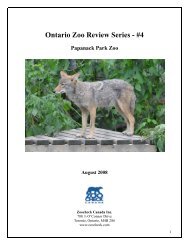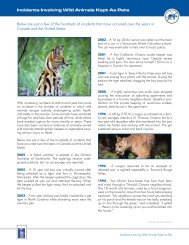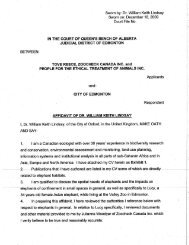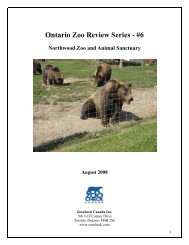Suffering, Not Smiling: The Truth About Captive Dolphins - Zoocheck ...
Suffering, Not Smiling: The Truth About Captive Dolphins - Zoocheck ...
Suffering, Not Smiling: The Truth About Captive Dolphins - Zoocheck ...
Create successful ePaper yourself
Turn your PDF publications into a flip-book with our unique Google optimized e-Paper software.
_______________________________________________________________SUFFERING, NOT SMILING<strong>The</strong> truth about captive dolphins_______________________________________________________________by theANIMAL CONCERNS RESEARCH AND EDUCATION SOCIETY (ACRES)supported byWORLD SOCIETY FOR THE PROTECTION OF ANIMALS (WSPA)Published by Animal Concerns Research and Education Society (ACRES).Compiled by: Louis Ng (BSc)Edited by: Farheen Mukri (M App. Sci.), Louis Ng (BSc)<strong>The</strong> Animal Concerns Research and Education Society (ACRES) is a nonprofitsociety, founded in May 2001 by a group of Singaporeans. ACRESaims to:• foster respect and compassion for all animals.• improve the living conditions and welfare of animals in captivity.• educate people on lifestyle choices which do not involve theabuse of animals and which are environment-friendly.ACRES office address5001 Beach Road #04-03 (Unit Q)Golden Mile ComplexSingapore 199588Tel: 62967758ACRES mailing address:Ghim Moh Estate Post OfficePO Box 1078Singapore 912703
7. <strong>The</strong> contact sessions with the dolphins are detrimental to the welfareof captive dolphins. <strong>The</strong> increased chances of disease transmission andthe safety of visitors also clearly dictate that this practice should beabandoned.8. <strong>The</strong> captive dolphins, must suffer the indignity of performing tricks totheir trainer’s whistle for a reward of dead fish. Forcing thesenotoriously shy species to perform unnatural acts is undoubtedlydetrimental to their welfare. <strong>The</strong> training methods employed also raiseserious concerns.9. <strong>The</strong> evidence provided suggest that minimal education takes place atdolphinariums. In fact, dolphin shows featuring dolphins performingunnatural acts clearly distort the public’s understanding of thesespecies. <strong>The</strong>se shows only serve to reinforce the idea that man is abovenature and controls it, rather than being a part of it.10. Research conducted on dolphins in captivity does not have the potentialto improve the conservation of wild cetaceans as the lives of captiveanimals are artificial. <strong>The</strong> limited value of captive studies and theincreasing ability to conduct research on wild dolphins all underminethe case for the continued research conducted on captive dolphins.11. <strong>The</strong> purpose of captive breeding is to produce a genetically-viable, selfsustainingpopulation of animals, whose progeny will eventually bereleased back into the wild. Producing this genetically-viablepopulation is simply not possible at Dolphin Lagoon since they only havesix dolphins. Continued breeding will only result in inbreeding.12. Although there are still many unknowns, there have been a number ofdolphin rehabilitations and releases that point to this as a viable optionfor many captive dolphins.13. Knowledge about dolphins can be conveyed more accurately throughnature documentaries and films that show dolphins in naturalsurroundings or by viewing dolphins in the wild. Both dolphins andobservers benefit as this conveys a more realistic picture of dolphin lifeat no cost to their welfare.14. Progressive countries around the world no longer keep dolphins incaptivity, clearly recognizing that these animals belong in the vast openseas. <strong>The</strong>re is also a growing movement within the marine park industryto discontinue keeping cetaceans in captivity.<strong>Suffering</strong>, not <strong>Smiling</strong>- 3 -
An inspection of the Dolphin Lagoon by the Animal Concerns Research andEducation Society (ACRES) in March 2003 raised several concerns regardingthe welfare of the dolphins and the apparent contradictions to the abovestated objectives of the Dolphin Lagoon. Education was minimal and therecreation and entertainment aspect of the facility were clearly the mainfocus.According to Aw (2001), “the Dolphin Lagoon runs up to four performancesusing the same three animals everyday, 365 days a year with no off days,no annual leaves, no bonuses.” 5 In addition, the animal shows featureddolphins displaying a wide range of unnatural behaviours, contradicting theearlier statements by UWS.An inspection by ACRES in August 2003 revealed that the Dolphin Lagoonnow runs three performances a day. Han and Euang, were the performersfor all three show.<strong>The</strong> Dolphin Lagoon has also established a petting session and a Swim-with-Dolphin program, which raises further concerns.It was clear from the investigation and a review of literature regardingcaptive dolphins, that the Dolphin Lagoon does not have a beneficial aspectin terms of dolphin research, conservation and education.In addition, it is clear that captivity is detrimental to the welfare of thesedolphins. Recent studies in the United States suggest an inordinate numberof captive dolphins are succumbing to stress-related illnesses such as heartattacks and gastric ulcers. 6 In 2001, Natam, the female dolphin atUnderwater World Singapore, died of acute gastritis. 7This report presents a compilation of current literature regarding captivedolphins and argues against keeping these animals in captivity. <strong>The</strong> reportpresents clear evidence that captivity is detrimental to the welfare ofdolphins and shows that research, conservation and education indolphinariums, have minimal benefits to wild populations of dolphins.<strong>Suffering</strong>, not <strong>Smiling</strong>- 5 -
“SUFFERING, NOT SMILING”CAMPAIGN OBJECTIVESWith immediate effect:• End the use of dolphins in animal shows at Dolphin Lagoon.• End the petting and Swim-with-Dolphin sessions at Dolphin Lagoon.• Stop the further imports of dolphins to the Dolphin Lagoon.• Begin research on the rehabilitation of the Indo-Pacific hump-backeddolphins and eventually release the Indo-Pacific hump-backeddolphins at the Dolphin Lagoon, back into the wild.• Prevent the establishment of new dolphinariums in Singapore.<strong>Suffering</strong>, not <strong>Smiling</strong>- 6 -
<strong>Suffering</strong>, not <strong>Smiling</strong>- 7 -
DOLPHIN BIOLOGY AND CONSERVATIONOne of the most popular group of animals in the world that have earned aplace in the hearts of millions of people, is undoubtedly the dolphins.<strong>Dolphins</strong> range throughout the oceans of the world and most live in fluidsocial groupings called pods. 8 Each pod consists of a number of individualsof varying ages who play, feed and travel together. 8 At certain times,groups of pods come together to form herds of several hundred orsometimes even thousand individuals. 8Dolphin language is a series of clicks, squeals and whistles. 9 <strong>The</strong> languagevaries from place to place and group to group which means that it is learnt,not inborn. 9 Individuals have distinct signature whistles, just like humannames, which others use to call them. 9Louis Herman, who has conducted communication experiments on dolphinsfor decades has said that dolphin intelligence is on par with chimpanzees,the closest living relative to man. 10 Examples of behaviour/emotionsobserved in cetaceans include: possessing culture, loyalty, compassion, cooperativehunting and problem solving, curiosity, creativity, joy, fear,loneliness, grieving, aggression. 10Indo-Pacific hump-backed dolphins (sousa chinensis)<strong>The</strong> Indo-Pacific hump-backed dolphin is one of the four species of dolphinsfound around Singapore waters. <strong>The</strong>y are inhabitants of tropical to warmtemperate costal waters and they also enter rivers, estuaries, andmangroves. 11 <strong>The</strong>se shoreline species 12 are found from northern Australiaand southern China in the east, through Indonesia, and around the costalrim of the Indian ocean to southern Africa. 11Groups of hump-backed dolphins tend to contain fewer than 10 individualsalthough some are up to 30. 11 <strong>The</strong>se dolphins usually swim slowly anddeliberately, surfacing briefly and at comparatively long intervals. 13 <strong>The</strong>yare moderately acrobatic, but often do not bowride. 11<strong>The</strong>y show a characteristic and widespread avoidance reaction to boats. 13,14<strong>The</strong>y rarely permit a close approach before diving, splitting up into smallgroups or single animals. 13 <strong>The</strong>y usually change course underwater,reappearing unexpectedly some distance away. 13 Porter (2001) furtherstates that they are notoriously shy and unwilling to learn the usual tricks<strong>Suffering</strong>, not <strong>Smiling</strong>- 8 -
commonly taught in Asian aquariums. 15variety of fishes including mullet. 12<strong>The</strong> dolphins feeds upon a wideThreats in the wild 9Hunting<strong>Dolphins</strong> are hunted for meat, leather, oil, fertilizer and animal feed.<strong>About</strong> 10,000 dolphins are killed annually in Peru for human consumption.In Japan, their meat is a delicacy. For one species of small cetaceansalone, the Dall’s porpoises, more than 10,000 are killed each year.FisheriesOne of the greatest threats to dolphins is being caught in fishing nets.Current estimates are that between one to three million dolphins areaccidentally killed each year. Some fishermen also believe that cetaceanscompete with humans for marine resources. From 1976 to 1982, 4,147bottlenose dolphins, 466 Pacific white-sided dolphins, 953 false killerwhales and 525 Risso’s dolphins were killed for fishery protection at IkiIsland, Japan. Scientists concluded that there was no evidence that thedolphins were responsible for the fishery’s decline. Instead,overexploitation by larger fishing vessels combined with pollution andnatural warm water current flows were the likely factors.PollutionIn many parts of the world, stranded dolphins are found to have swallowedplastic bags or have nylon straps wrapped around their tail flukes. Plasticbags and other rubbish when eaten can block the digestive tract and causeulcers. Abandoned fishing lines and ropes entangle dolphins and trap themunderwater where they drown. Effluents from factories, pesticides,herbicides and fungicides from farms and gardens get washed by rain intothe rivers and drains into the ocean. This gets into the fish, squid, crabs,shrimps and other crustaceans, which is food for the dolphins.Habitat destructionMangroves and reefs play a crucial role in the ocean ecosystem and thefood supply of the dolphins because they are the sheltered breeding groundof the dolphins’ food. Some 58% of mangrove forest in Southeast Asia hasbeen lost, much through conversion into saltwater ponds for farmingprawns and fishes, and through cutting to provide woodchips and costaldevelopments.Capture for marine parks and dolphinariumsSee next section<strong>Suffering</strong>, not <strong>Smiling</strong>- 9 -
DOLPHIN CAPTURE METHODS“Marine parks may have their defendersbut they have no reasonable defense.”~ WDCS 10Contributing to the extinction of a speciesCurrently many zoos and marine parks that feature dolphin exhibits orshows are capturing dolphins or buying captured dolphins. 9Four of the dolphins at the Dolphin Lagoon in Singapore were similarlycaught from the wild. 2 <strong>The</strong>y were obtained from Thailand where the WorldConservation Union (IUCN) has stated that “Hump-backed dolphins aretaken in fishing gear in the upper Gulf of Thailand, and the demand for livespecimens in Thai Oceanaria has recently lead to the development of adirected fisheries there.” 3Indo-Pacific hump-backed dolphins are highly endangered and theacquisition of these wild caught dolphins by UWS will clearly contribute tothe extinction of this species. Indeed, Indo-Pacific hump-backed dolphinsare on longer found in large parts of their former range in inshore waters ofThailand. 3UWS however justified their acquisition claiming that these dolphins wouldhave ended up as meat if UWS had not acquired them. 67 Aquariumscommonly defend their practice by claiming to “rescue” animals whichwould have been marketed as meat; yet in reality, and according to localpeople, they are encouraging and subsidising drive hunts which might nototherwise have been conducted. 10<strong>Suffering</strong>, not <strong>Smiling</strong>- 10 -
Cruel captures<strong>The</strong> cruel capture methodsemployed also impose severestress on the dolphins. Tocapture dolphins, dolphin podsare chased into shallow waterswhere they are netted and thebest specimen(s) selected. 9<strong>The</strong> rest are simply thrownback. 9In Japan, live dolphin capturesoccur alongside the killing ofdolphins for meat in what areknown as ‘drive hunts’. 16Dozens of dolphins may berounded up out at sea anddriven towards the shore, usingboats and loud noises, where abay may be netted off,trapping the animals inside. 16Once trapped, the selectionprocess begins, with somedolphins removed from thenets alive, for sale to marineparks and aquariums. 16 <strong>The</strong> restare slaughtered forconsumption. 16Between 1938 and 1980 theUnited States alone took over1500 live dolphins from thesea, and between 1980 and1990 Japan took 500 to be usedin entertainment. 17Doug Cartlidge, former Curator of SeaWorld Australia in 1974 describes hisharrowing experience during a dolphincatch for Sea World Australia off theGreat Barrier Reef that eventuallyprompted Cartlidge to quit thebusiness for good. "We caught threedolphins in our net and were bringingthem in slowly," he recounts. "<strong>The</strong>first old one was too big for a showdolphin. <strong>The</strong> next one was scarredwhere sharks had had a go at it andwas too big anyway, so they both wentover the side. <strong>The</strong> next one was abeautiful six-footer and as clean as awhistle. 'We'll have this one', wedecided, and we started to pack up.<strong>The</strong>n I saw the two dolphins we hadput over the net just sitting about 30ftaway, looking at us. I don't know whatit was but I just felt guilty. And thensuddenly it hit me. I realised what wehad was their two year old baby. Allthe way back to the main boat theyfollowed us. I was near to tears. It wasthe way they were looking at me.<strong>The</strong>y weren't sitting up in the water,they were just lying on their sides andwatching with one eye out of thewater."More than any other single factor, saysCartlidge, it was this experience thatcaused him to turn against theindustry, and take his case to thepublic. “It is no crusade,” he insists.“I can only publicise what is wrong inthe industry until the public sees it'swrong. When that happens, at leasttwo childless dolphins out in thePacific Ocean will finally have madetheir point.” 6<strong>Suffering</strong>, not <strong>Smiling</strong>- 11 -
CAPTIVITY – A LIFE OF SUFFERING"One of the most typical – not to say reprehensible –examples of man's continued ignorance as regards thekeeping of animals in captivity is the latest trend towardskeeping cetacea in oceanaria or dolphinaria to train them,an activity which became fashionable in the 1940's. Inessence this is no different from the old attempts to satisfyman's curiosity by means of performing animals inmiserable traveling circuses or showmen with their pitifuldancing bear acts."~ Professor Giorgio Pilleri 6“Imagine you are a young dolphin. <strong>The</strong> oceanis your playground and you swim up to 40miles a day, chasing fish and playing withyour friends. Now imagine that you areripped violently from your home and sold toa marine park where you have to jumpthrough hoops and interact with payingcustomers to get fed. Between shows you areforced to wait in a pool of water that'sbarely big enough to contain you. Sadly, thisis what life has to offer for the hundreds ofdolphins kept in captivity throughout theworld.” 18Cetaceans have been held in captivity forover one hundred years, subjects ofhumankind’s desire for animalentertainment, research, and, more recentlyFigure 2. <strong>Suffering</strong>, notsmiling.for direct and personal interaction. 16 <strong>The</strong> dolphin’s permanent smile oftenhides an inner suffering. 16<strong>Suffering</strong>, not <strong>Smiling</strong>- 12 -
AcclimatisationAccording to dolphin captor JaySweeney, “Most aquatic mammalshoused in captive enclosures havebeen acquired from free-livingsources. Few, if any, have hadexposure or contact with humans andthey have not been enclosed within arestricted space until the suddenevent of their capture. At this time itbecomes necessary for them not onlyto cope with capture, but alsoimmediately begin to consume deadfish. <strong>The</strong>y must adjust to restrictionsin their free-ranging mobility, beingPryor, formerly associated withSea Life Park Hawaii, describedthe dietary portion of theacclimatisation process:“Eating dead fish instead ofchasing down live ones is atremendous change; dead fishare by no means recognisable asfood at first. Force feedingthrough a stomach tube issometimes necessary to keep ananimal alive until it learns toaccept an artificial diet.” 20placed in land-based pools, which may be absent from the visual andauditory sensory stimuli of their natural habitat. <strong>The</strong>y are required toacknowledge the presence of, and eventually accept, contact withhumans.” 19 In other words, everything that follows capture is a forcedassociation. 10An unnatural lifeAlthough subtle and less visible,the greatest abuse suffered bycaptive cetaceans lies inconfinement itself. 10 <strong>The</strong>enormity and diversity of theirnatural habitat is in starkcontrast to the alien, minusculeconfines of captivity. 10“Managers of captive species shouldnever fool themselves with thebelief that they can replicate naturein a captive setting.To expect this outcome woulddemonstrate an ignorance of theintricacies and complexities thatcharacterize natural ecosystems.” 21Free-living cetaceans live in three-dimensional surroundings. 10 <strong>The</strong>y arecapable of deep diving, and many species spend less than 20 per cent oftheir time at the water's surface. 10 In their natural environment, they arealmost always in motion, even while resting. 10Cetacean scientists studying wild populations point to the fact that dolphinsand whales travel great distances during their normal lives. 8 <strong>The</strong>seconditions cannot be duplicated in captivity, so many experts believe thatthe physical activity experienced by captive cetaceans falls far short ofwhat is appropriate and necessary for adequate physical health. 8 Mostbelieve it is not possible to adequately house and care for intelligent,<strong>Suffering</strong>, not <strong>Smiling</strong>- 13 -
social, wide-ranging ocean mammals incaptivity. 8 Boredom, frustration, restrictionof normal activities and sensory deprivationare cited as some of the most seriousconcerns. 8<strong>Dolphins</strong> also maintain complex societies,form strong bonds, and are known tocommunicate with each other. 10 Whendolphins are captured from the wild, theyare removed from their natural socialstructures and forced into artificiallycontrolled groupings. 8 <strong>The</strong> normal sex ratio,age make-up and number of animals perpod, is vastly different from what theyIndo-Pacific hump-backeddolphins have a homerange of 30-400 squarekilometers in the wild. 22<strong>The</strong> Dolphin Lagoon inSingapore measures onehectare. This representsonly 0.0003 per cent ofthe dolphin’s naturalhome range. Clearly, thisis detrimental to thewelfare of the animal.would experience in the wild. 8 <strong>The</strong>se dolphins are torn from their naturalsocial environment, deprived of their need to associate with their own kindand sentenced to a lifetime of confinement. 10Cetacean specialist Professor Giorgio Pilleri, who has studied dolphinintelligence and behaviour for 20 years, concluded: “Whatever efforts aredeployed, the keeping of cetaceans in captivity will always pose problemsbecause of the inherent contradiction on which it is based: the keeping incramped conditions, of creatures which are accustomed to vast openspaces.” 6Effects of captivityScientific evidence indicates thatcetaceans in captivity sufferextreme mental and physical stress,which is revealed in aggressionbetween themselves and towardshuman, boredom, and a lower lifeexpectancy and higher infantmortality then in the wild. 16Aggression between themselvesIn 2003, Jumbo, the maledolphin from the Dolphin Lagoonhad 11 teeth extracted. 23,24 Hehad been fighting with anothermale dolphin through the barsseparating their lagoons. 23,24 Thisindicated extreme mental andphysical stress in the dolphin.Professor Pilleri believes thatcaptivity, coupled with the destruction of the dolphin's sophisticated socialstructure, causes “profound psychological disturbance, and neuroticbehaviour almost identical to that of humans when held in solitaryconfinement.” 6 <strong>The</strong>se symptoms, he adds, "exacerbated by the utterlydegrading tricks they are forced to perform in captivity," include loss of<strong>Suffering</strong>, not <strong>Smiling</strong>- 14 -
communication, despair and suicidal behaviour, and an unnaturalaggression probably induced by feelings of intense claustrophobia. 6Stress-related illnessNatam, the femaledolphin at DolphinLagoon had similarlydied of a stressrelatedillness. Shehad succumbed toacute gastritis. 7Indeed, recent studies in the United Statessuggest that an inordinate number of captivedolphins are succumbing to typical stressrelatedillnesses such as heart attacks andgastric ulcers. 6 It can hardly be sheercoincidence that virtually identical disordersaffect millions of human beings forced toendure tedious and repetitive menial work. 6<strong>The</strong>se stress-related illnesses are associatedwith animals that are presented with nooptions during stressful events. 26 Mediated bythe pituitary gland, this type of stress response is characterized byincreased adenocortical activity and vagal tone, decreased hormonalactivity, and chronic blood pressure elevation. 26 Clinical signs associatedwith this type of stress response include gastric ulcers and eventuallydeath. 26ConclusionCaptivity defies, depresses, and denies theinstincts which define each animal. 10It is clear that it is impossible toaccommodate the mental, physical andsocial needs of dolphins in captivity andthat it is cruel to confine them. 16 OneJapanese whaler has said, “Ethically, it isbetter to let an animal live a free andnatural life and then kill it - even ifpainfully - than to imprison it for its wholelife before killing it.” 25<strong>The</strong> late ocean explorerJacques Cousteau statesthat: “No aquarium, notank in a marine land,however spacious it maybe, can begin to duplicatethe conditions of the sea.And no dolphin whoinhabits one of thoseaquariums or one of thosemarine lands can beconsidered normal.” 8Indeed, once captured and confined, most dolphins will never again escapetheir nightmare world of stress, insecurity and neurosis except through themerciful release of death. 6<strong>Suffering</strong>, not <strong>Smiling</strong>- 15 -
CONTACT SESSIONS: THE TOUCH OF DEATH“Every trainer and every dolphin owner is well aware thatdolphins in captivity are highly prone to contagious diseasescarried by humans. <strong>The</strong>y also know very well that some ofthese fatal infections are passed on to the dolphin in suchseemingly innocuous ways that no one would even think ofobjecting. And yet it will remain a never-ending mysteryhow many dolphins have died because they have contractedsome childhood illness, or even 'flu or the common cold.Certainly, those at the receiving end of the 'educational'lesson won't be told. Nor will the shy yet delighted child whois encouraged to come down onto the stage, and whoseloving kiss for the dolphin turns into a kiss of death.”~ <strong>The</strong> Rose Tinted Menagerie 6By imposing human contact on captivedolphins, petting pools furtherexacerbate the stress already wrought bycaptivity. 28 For many years, the Whaleand Dolphin Conservation Society (WDCS)and <strong>The</strong> Human Society of the UnitedStates (HSUS) have expressed concernsabout the potential risks to both humansand dolphins associated with physicalinteraction programs. 28 In the report byWDCS and HSUS, Biting the hand thatfeeds: <strong>The</strong> case against dolphin pettingpools, clear and compelling evidenceprovided, based on a five year study,justify the immediate closure of allpetting pools (dolphin petting andfeeding programs) on public safety andanimal welfare grounds. 28Figure 3. A visitor getting akiss from the dolphin atDolphin Lagoon.<strong>Suffering</strong>, not <strong>Smiling</strong>- 16 -Figure 4. Sign at DolphinLagoon, advertising thecontact sessions.
Welfare of the dolphinsIndo-Pacific hump-backedResearch generally suggest thatdolphins are notoriously shydolphins in the wild and captiveanimals and show asituations do show signs of not beingcharacteristic and widespreadcomfortable during ‘Swim-with-Dolphin’sessions. 27avoidance reaction toFor example, wild dolphinsboats. 13,14 <strong>The</strong>y rarely permitin the Bays of Islands, New Zealandavoid swimmer interactions. 29 a close approach beforeSimilarly,diving, splitting up into smalldusky dolphin schools, become moregroups or single animals. 13compact during morning and early<strong>The</strong>y usually change courseafternoon interactions withswimmers. 30 underwater, reappearingThis type of behaviour isunexpectedly some distanceobserved when dolphins are inaway. 13situations of surprise, threat or dangerand it may be a form of protection. 31<strong>Dolphins</strong> have also been shown to surface more often during ‘Swim-with-Dolphin’ sessions. 27 This increased respiration rate of an animal is anindicator of stress. 32,33In the study by Kyngdon et al. (2003), there were also signals that thedolphins did not want swimmers in their pool. 27 <strong>The</strong> dolphins occasionallyexhibited the body slaps, charges and abrupt behaviours that Frohoff (1993)ascribed to frustration. 34 Dolphin charges were also seen occasionally. Thisis when the dolphin swims quickly towards a swimmer with its rostrumopen, and at about one metre away, it abruptly changes direction. 27Dolphin Lagoon also feature pettingsessions with the dolphins. Duringthese sessions, part of the dolphin’sbody is out of the water, and thedolphin’s sensitive skin is continuallyexposed to the hot sun (fig. 5). In thewild, a dolphin protects its sensitiveskin from the hot sun by diving todeeper waters. 1 In dolphinariums withno shade from the hot sun, somedolphins have developed serious Figure 5. Dolphin petting sessionsunburn and blisters on their skin. 1 at Dolphin Lagoon.<strong>Suffering</strong>, not <strong>Smiling</strong>- 17 -
Effects on wild dolphinsWDCS and the HSUS are alsoconcerned that, by promoting andreinforcing the acceptability offeeding and touching dolphins,captive feeding programs willencourage the public to repeattheir experiences with wildcetaceans. 28 <strong>Not</strong> only is pettingand feeding wild dolphinspotentially dangerous, it also hasa detrimental effect on wildcetaceans. 28Figure 6. Indo-Pacific hump-backeddolphins are shy animals but areforced to endure contact sessionswith humans.In addition to the risk of poisoningor other food-related hazards,wild dolphins that approach, orrely upon humans for food are atrisk of collision with boats and their propellers, entanglement in nets, orattack by sharks. 28 Furthermore, wild dolphins conditioned to seek foodfrom humans can become less willing to hunt for themselves and may notteach their young vital hunting skills. 28 Wild feeding may also attract nonlocaldolphins to an area, placing stress on the ecosystem, which may nothave the capacity to sustain the increased population. 28Indeed, according to WDCS, there is a growing problem of peopleattempting to feed wild dolphins. Some of this behaviour may come fromthe perception that it is 'acceptable' to do so. Petting Pools may havefostered this perception.<strong>Suffering</strong>, not <strong>Smiling</strong>- 18 -
Disease transmission<strong>The</strong> contact sessions with the dolphinsalso increases the chance of diseasetransmission between dolphins andhumans (vice-versa).<strong>The</strong> United States National MarineFisheries Service (NMFS) has acknowledgedthat the potential exists for transmissionof diseases between wild marine mammalsand humans. 28It is clear that diseasetransmission can occur andthe chances are greatlyincreased during thedolphin contact sessions.This wider contact betweenanimals and humans hasbeen attributed as one ofthe causes of the increasingspread of viruses fromanimals to human.Marine mammals are known to carrypathogens that can infect humans. 28 AsNMFS has noted, not only do bites frommarine mammals carry a danger of infection, but there are a number ofdisease agents that are common to both humans and marine mammals andcan be transmitted between them. 28 For example, a variety of opportunisticbacteria found on the skin of dolphins may pose a threat to human health,and several fungal and viral agents which can affect marine mammals havebeen or can be transmitted to humans. 28Outbreaks of infectious disease reported in dolphins also include erysipelas,pasteurellosis, hepatitis, Pseudomonas pseudomallei infection, andsystemic mycosis. 10Acute hepatitis has also occurred in several devastating outbreaks. 10 In1986, more than 20 animal care workers were vaccinated as a precautionagainst hepatitis after two pseudorcas (false killer whales) died at SeaWorld from hepatitis-like symptoms. 10While there has been no recorded incidence of human-dolphin diseasetransmission at Dolphin Lagoon, it should be noted that the recent diseases(e.g. monkeypox) from animals also had no earlier recorded incidences. Itis clear that we unnecessarily expose ourselves to possible diseases whenwe come into close contact with the dolphins.<strong>Suffering</strong>, not <strong>Smiling</strong>- 19 -
Public safetyMedia reports and historic government records reveal a range of seriousinjuries caused to visitors by captive dolphins in interactive programs,including cuts, bruises, broken bones, bites and rakes. 28,36 Since 1996, WDCShas also recorded several incidents, including bites and head butts. 28This risk of injury is also recognized by a study in 1994 on Swim-with-thedolphinprograms, which details aggression and other high-risk behaviour bydolphins directed at the visitors in the water with them. 35This aggressive tendency has also been noted in the wild. At Monkey Mia,Western Australia there is an unofficial policy of not feeding or encouraginginteraction with adult male dolphins. This is to reduce the risk of aggressiveattacks. 37Santos (1995) also reported a case where a sociable male bottlenosedolphin named Tiao, deliberately attacked and killed a man and injuredseveral swimmers after apparently being harassed by people who wished tointeract with him. 38Contact sessions with dolphins are not an entirely safe activity and thereare serious risks involved. <strong>The</strong> literature strongly suggests that in humandolphininteraction situations, it is important to be aware of the potentialfor aggressive behaviour, which may endanger humans. 37This risk is seldom mentioned in tourist promotions or in popular literature,which perhaps understandably, emphasizes the positive aspects ofinteracting with dolphins. 37<strong>Suffering</strong>, not <strong>Smiling</strong>- 20 -
Conclusion: an inherent contradiction to policies in the wildWhile the petting and Swim-with-Dolphin programmes at the DolphinLagoon appear to be more carefully regulated than those in the UnitedStates, there is still undisputed concerns for the welfare of the dolphinsand the safety of the human visitors. In addition, these contact sessions willclearly cause distress to this species since Indo-Pacific hump-backeddolphins are shy animals and rarely permit a close approach by humans inthe wild.<strong>The</strong> compelling evidence provided indicates that these contact sessions aredetrimental to the welfare of captive dolphins. <strong>The</strong> increased chances ofdisease transmission and the safety of visitors also clearly dictate that thispractice should be abandoned.Progressive countries have already acknowledged these facts and havetaken steps to address this occurrence in the wild.• Petting and feeding wild dolphins constitutes the offense ofharassment under the Marine Mammal Protection Act in the UnitedStates. <strong>The</strong> United States government has further launched a publiccampaign to deter feeding, touching and swimming with dolphins inthe wild. 28• In Scotland, the code of conduct, developed under advice from themarine biologists at the University of Aberdeen, states thatpassengers or crew should not swim with, touch or feed dolphins orother marine mammals. 17• In Monkey Mia, Western Australia, people are no longer permittedto touch the dolphins. 37• <strong>The</strong> Hong Kong dolphin watching code of conduct similarly statesthat “For the safety of all concerned, do not attempt to touch,swim with or feed marine animals – swimming with and touchingwild cetaceans may be dangerous and may transfer deadlyinfection.” 39<strong>Suffering</strong>, not <strong>Smiling</strong>- 21 -
CRUELTY PARADING AS ENTERTAINMENT“What makes the dolphin show a unique attraction isprecisely the very thing that reduces the industry to the roleof slave-trader, for behind the frozen clown-like smile, theoptical illusion of flippering happiness, there is thegrotesque tragedy of a highly-perceptive and intelligentbeing incarcerated to provide humans with entertainmentand profit.”~ <strong>The</strong> Rose-Tinted Menagerie 6All shows follow the same pattern. First, as the audience files through theturnstile and finds their seats, the rousing rock or pop music begins, withthe dolphins becoming visibly nervous and excited, leaping out of the waterand making fast underwater circuits around the pool. 6 But the music is notreally for the benefit of the public at all, but used as a form of Pavlovianconditioning which the hungry dolphin associates with food-reward, alertingthe animal that the show is about to begin. 6According to Aw (2001), “the DolphinLagoon runs up to four performancesusing the same three animals everyday,365 days a year with no off days, noannual leave, no bonuses.” 5 An inspectionby ACRES in August 2003, revealed similarresults. Although there were only threeshows a day, Han and Euang were theperformers for all three shows.Unlike certain species ofdolphins, Indo-Pacific humpbackeddolphins are onlymoderately acrobatic. 11Porter (2001) further statesthat they are notoriouslyshy and unwilling to learnthe usual tricks commonlytaught in Asian aquariums. 15<strong>The</strong> animal shows also featured dolphinsdisplaying a wide range of unnaturalbehaviours, contradicting the earlier statements by UWS stating that thedolphins would not be made to perform tricks “which are unnatural”. 4<strong>The</strong>se captives dolphins, must suffer the indignity of performing tricks totheir trainer’s whistle for a reward of dead fish. 16 In the wild, dolphins usetheir natural instinct to hunt for food. 1 <strong>The</strong>ir bodies are built for speed andcatching fish is fun. 1 All they have to look forward to in captivity are somedead offerings after they have performed their tricks. 1<strong>Suffering</strong>, not <strong>Smiling</strong>- 22 -
Unnatural behaviours in the dolphin show at Dolphin LagoonFigure 7. <strong>The</strong> dolphins, beachingthemselves onto the stage.Figure 8. <strong>The</strong> dolphinsbalancing balls on theirrostrum.Figure 9. Dolphin jumping through hoops.Figure 10. <strong>Dolphins</strong>swinging hula-hoops ontheir rostrum.Figure 11. <strong>Dolphins</strong> being used as waterskis.<strong>Suffering</strong>, not <strong>Smiling</strong>- 23 -
If they refuse to perform, then in many cases they'll just go hungry. 6 It is anessential part of the Pavlovian conditioning regime that the dolphin mustbe kept sufficiently hungry in order to perform tricks at the command ofthe trainer. 6 Indeed, the only reason they perform is because they arehungry. 1During show time, small morsels of food, judiciously controlled by thetrainer, become the incentive and reinforcing stimulus for the animal tosuccessfully accomplish each stunt. 6Deliberate punishment is also an integral part of the training regime, claimsDoug Cartlidge, former whale and dolphin trainer and Curator of Sea WorldAustralia: "<strong>The</strong> tricks are not performed because they enjoy doing them.First you find out how much they'll eat and still work. After that youcondition the dolphin to associate certain hand signals with certain tricksthat will result in the dolphin getting fish. You then find out if they areloners or prefer company because one of the punishments if they are notworking properly is to lock them away on their own. You put them in a penand ignore them. It's like psychological torture." 6<strong>The</strong> dolphins at the Dolphin Lagoon are also made to beach themselves onthe stage (fig. 7). This is clearly an unnatural behaviour and against theinstinct of the dolphins.According to dolphin trainer Rocky Colombo at Italy's Ocean WorldAquarium, one of the first priorities in taming the newly caught anddelivered dolphin is to condition its attention away from the underwaterenvironment to the 'open-air' environment of the stage, the trainer, theprops and the audience. 6 To expedite this subtle form of brain-washing, theanimal - much to its initial reluctance and instinctive fear - is activelyencouraged to wriggle out of the water and onto the stage. 6 Hunger and thetempting reward of a fish dangling just out of reach helps the dolphin toweigh up the decision on whether to trust human orders or animal instinct. 6<strong>Suffering</strong>, not <strong>Smiling</strong>- 24 -
ConclusionForcing these notoriously shy species toperform unnatural acts is undoubtedlydetrimental to their welfare. <strong>The</strong> trainingmethods employed raise serious concerns.In the wild, the dolphin will play and jumpwith spontaneous exuberance and the sheerjoy of being alive; in captivity that isreplaced by dressage that is artificial andconditioned, part of an enforced clockworkroutine. 6Figure 12. <strong>The</strong> unnaturalbehaviours displayed bydolphins at the DolphinLagoon.<strong>Suffering</strong>, not <strong>Smiling</strong>- 25 -
EDUCATION: DISTORTING PUBLIC UNDERSTANDING“To expect an industry with so much to hide to providethe kind of lucid, objective, and all-encompassinglessons which most parents expect from education,borders on criminal naivety.”~ <strong>The</strong> Rose Tinted Menagerie 6<strong>The</strong>re are some who feel that seeing a live dolphin on display is aneducational experience. 9 However, captive dolphins do not exhibit thesame behaviour as their wild counterparts because of the totally differentliving conditions. 9 <strong>The</strong> complex nature of dolphins’ lives cannot possibly bedemonstrated in captivity. 16It is thus questionable whether marine parks and dolphinariums are trulyeducational or as claimed by WDCS, “marine parks and dolphinariumssignificantly distort the public’s understanding of the marineenvironment.” 16Is this truly educational or even necessary?A 1989 study by Dr. Stephen Kellert ofYale University assessed public attitudesand knowledge gained in three zoos.A quote from his report by WilliamDonaldson, president of the ZoologicalSociety in Philadelphia, states: “<strong>The</strong>surveys we have conducted...show thatthe overwhelming majority of our visitorsleave us without increasing either theirknowledge of the natural world or theirempathy for it. <strong>The</strong>re are even timeswhen I wonder if we don't make thingsworse by reinforcing the idea that man isonly an observer in nature and not a partof it.” 40Majority of the educationalsigns at the Dolphin Lagoonare placed in obscurelocations. A study conductedby ACRES revealed that only2 % (n = 483) of the visitorsto the lagoon read theseeducational signs. It is thusclear that minimaleducation took place at theDolphin Lagoon and theentertainment aspect ofmarine parks overwhelmsthat of education.In his study, Dr Kellert's assessment of attitude changes in the public beforeand after a visit indicated that little change took place. 40 <strong>The</strong> study statesthat evidence of a more informed and appreciative public following the zoovisit is neither impressive nor reassuring. “We failed to observe any<strong>Suffering</strong>, not <strong>Smiling</strong>- 26 -
appreciable increase in either factual or conceptual knowledge of animals,”and “the meager understanding of visitors following the visit was among thedisappointing results of the study.” 40 Dr Kellert further stated that, “mostvisitors tend to regard these facilities as park-like settings for theexperience of casual family entertainment largely distinct from the pursuitof increased knowledge of wildlife.” 40No hard evidence is also known to exist, supporting the statement thatpublic display translates into public action to protect species and preservethe environment, as claimed by marine parks. 10 While some facilities createopportunities for visitors to participate in beach clean-ups and otherpositive efforts, few can demonstrate direct examples translating intopublic action. 10Another analogy that completely contradicts the appreciation myth (ie.that animals must be seen "up-close" in order to foster understanding of aspecies), is the increasing interest in dinosaurs. 10 Children and scientistsalike have expressed enormous interest in, and fascination with theseextinct species never seen by man. 10 Dinosaur parks and festivals, featuringrealistic, moving life-size models, are breathing new life into the tourismindustry. 41Distorting public understanding of the marine worldAs observed at Dolphin Lagoon, captive dolphins are often trained toperform tricks that cannot be observed among wild dolphins of thatparticular species. <strong>Not</strong> only may this cause stress to the dolphins, suchperformances run contrary to the conservation-oriented educational thrustof displaying captive dolphins as it emphasises spectacular entertainmentover realistic education. 9Educational messages clearly take second place to the whale and dolphinperformances, where jumping and splashing are the main features and anyeducational aspects are lost amidst the glamour and excitement of theshow. 10,16 Visitors often remember the visual image more than the contentof the commentary. 42<strong>Suffering</strong>, not <strong>Smiling</strong>- 27 -
ConclusionAre marine parks and dolphinariums educational? <strong>The</strong> evidence providedsuggests that minimal education takes place at these facilities. In fact,dolphin shows featuring dolphins performing unnatural acts clearly distortthe public’s understanding of these species. <strong>The</strong>se shows only serve toreinforce the idea that man is above nature and controls it, rather thanbeing a part of it.In addition, majority of the educational signs at the Lagoon are placed inobscure locations. A study conducted by ACRES revealed that only 2 % ofthe visitors to the lagoon read these educational signs. It is thus clear thatthere was minimal education taking place at the dolphin lagoon andclearly, the entertainment aspect of marine parks overwhelms that ofeducation.<strong>Suffering</strong>, not <strong>Smiling</strong>- 28 -
<strong>Suffering</strong>, not <strong>Smiling</strong>- 29 -
For example, Jefferson’s (2000) three year study of wild Indo-Pacific humpbackeddolphins provided vital data on the distribution and abundance ofthe dolphins. 22 In addition, data on movement patterns, home ranges andsocial organisation, feeding habits, growth, reproduction, eco-toxicologyand stock structure were also collected. 22 <strong>The</strong>se data, which have beenvital in developing conservation strategies for the protection of thesedolphins, could never have been obtained in a captive environment.Techniques for use in the wild have become increasingly sophisticated. 44Visual sonar, radio and satellite tracking are becoming routine allowingmuch more information to be collected than was possible in the past. 44Because of the complexities of the natural environment such research mayprove more directly relevant to conservation of wild species. 44List of research conducted in captive environments and factorsthat influence it 44Blood chemistryOver the years the justification for the research has expanded fromdetermining baseline levels from which to assess the health of animals incaptivity to being able ‘to diagnose disease problems in wild populations’. 45Normal ranges for haematology and blood biochemistry have beenestablished for the majority of commonly held whales and dolphins. Whilstthis data is useful for monitoring the health of captive animals, theirrelevance to free-living animals is limited because captivity leads toalterations in basic haematology and blood biochemistry.<strong>The</strong> physical fact of confinement has profound effects on many aspects ofcetacean physiology and ecology. Basic haematology and biochemistryparameters are altered for several reasons including the stress of captivity,routine medication such as de-worming and diet. Shallow pools andrestricted areas for travel mean that adaptive changes associated with thephysiological requirements of diving and foraging may be lost.Wild bottlenose dolphins have significantly higher white blood cell (WBC)counts, a lower percentage of neutrophils and a higher percentage ofeosinophils than captive dolphins. 46 Beluga whales showed a progressivedecline in packed cell volume and haemoglobin during a 10 week period incaptivity which was attributed to a reduced oxygen demand as a result ofthe imposed period of relative inactivity. 47 <strong>The</strong> whales also had a decreasethen increase in WBC, associated initially with a fall in eosinophil andlymphocyte numbers, followed by an increase in neutrophils.<strong>Suffering</strong>, not <strong>Smiling</strong>- 32 -
<strong>The</strong> artificial diets of captive animals also affect some aspects of theirblood chemistry. Levels of blood urea nitrogen (BUN) are related to theprotein content of the diet and cholesterol and triglyceride levels areaffected by the fat content. BUN levels were lower in captive bottlenosedolphins than in wild dolphins and cholesterol and triglyceride levelshigher. 46 <strong>The</strong> levels of triglyceride rose and cholesterol level fluctuated inbeluga whales kept in captivity for 10 weeks and fed on oil-rich herringrather then their normal diet of decapod crustaceans. 47Another difference between wild and captive species has been detected incirculating levels of the thyroid hormones thyroxine (T3) andtriiodothyronine (T4).In free living belugas, there are seasonal variations in T3 and T4, withlevels significantly higher in the summer than in the winter. 48 This seasonalvariation is not seen in captive belugas, which is attributed to theirrelatively constant environment.In addition, significant individual variation in haematology has beenrecorded in the beluga, 45 harbour porpoise 49 and orca 50 which has ledBossart and Dierauf (1990) to conclude that: “...individual baselines mustbe established for each animal in one’s care before being confident thatany particular value is abnormal.” 51<strong>The</strong>refore, there are limitations to any potential use of haematology datain investigating disease in wild animals because of the need to know what isnormal for any one individual. Before firm conclusions can be drawn, therewould need to be repeated sampling from an individual or, at least,extensive sampling from the population to gain some idea of the normalrange. Neither approach would be practical in the field.<strong>The</strong> relevance and application of haematology and blood chemistry datacollected from captive animals to wild animals is clearly questionable.BreedingAll the research on reproduction using captive animals is clearly relevant tothe successful breeding of animals in captivity. It is important tounderstand growth rates and normal calf behaviour to monitor the health ofnewborns. Knowing the most fertile periods will help determine when tointroduce males to females with the best chances of success.Basic reproductive data on calving intervals and age at sexual maturity hasbeen obtained for some species. Studies of the reproductive cycle have<strong>Suffering</strong>, not <strong>Smiling</strong>- 33 -
een used to estimate age at sexual maturity and calving interval oforcas, 53,54 and bottlenose dolphins. 55However, the highly controlled environment of the aquarium is a long wayfrom that of the ocean. Feeding has a marked effect on these parametersand the unnatural composition and idealised nature of zoo diets mean thatanimals may be growing more quickly and reproducing earlier and morefrequently than in the natural environment.Nutrition is likely to be linked to age at sexual maturity and calving intervalas it is in many other species, which limits how these values could be usedin a management or conservation context.Three of the many factors likely to influence calving intervals are forexample; food availability, whether a suitable mate is present at thecorrect time; and general health.Values that are established in captivity would have to be very carefullyverified in the wild if they were to be applied in management regimes. Itwould be dangerous to apply this information directly to the conservationand management of wild populations as it may overestimate theirreproductive capacities.DiseaseImportant differences exist which make captive animals a poor model fordisease in free-ranging populations. For example, captive animals do notcarry a parasite burden as they are routinely treated with anthelmintics. Incontrast, parasitic disease is ubiquitous in wild cetaceans. In addition,knowledge from captive studies of disease has given little insight into therecent outbreaks of morbillivirus disease and large-scale mortality of somespecies of dolphins.In addition, when outbreaks of disease have occurred in wild cetaceans, theliterature on diseases in captive animals does not appear to have been veryhelpful in its investigation.In particular, studies of diseases in captive animals have not helped inunderstanding some of the most visible marine mammal mortality events inrecent years. <strong>The</strong>refore, from a conservation perspective, there is littlevalue gained from disease studies on captive animals.PhysiologyExercise and respiratory physiology has been studied using animals trainedto undertake tasks in a pool or to accompany boats to sea. Whilst these<strong>Suffering</strong>, not <strong>Smiling</strong>- 34 -
have provided interesting knowledge about comparative physiology, theyhave been limited by the physical dimensions of pools (precluding studieson diving) together with the relatively sedentary life style and abnormaldiet of captive animals. If such data were to be used uncritically inmanagement programmes, it could be misleading.Physiological studies can give interesting insights into the way in whichcetaceans are adapted to their marine existence. This knowledge enrichesour understanding of these animals and provides interesting comparativedata.However, it seems to have little obvious practical application in theconservation of animals in the wild. In particular, studies of nutrition andenergetics are likely to be poor predictors of the performance of wildanimals because of the sedentary life style of captive animals and theirconsequent lack of basic fitness and abnormal diet.PsychologyFascinating as the data from captive studies of cognition and consciousnessmay seem, it may be fulfilling humans’ needs rather than those of theanimals concerned. Whether this justifies the imposition of captivity andexperimentation remains in question.BehaviourA great deal of behavioural work undertaken in dolphinariums has beenconcerned with how to train whales and dolphins to undertake certaintasks. 52 <strong>The</strong>se have primarily been for display purposes but also formanagement such as blood and urine sampling.Training techniques rely on operant conditioning where a reward is givenfor the correct behaviour and none given if the wrong behaviour isperformed. This has no obvious relevance to the behaviour of cetaceans intheir natural habitats.Captivity, which imposes conditions, clearly has effects on social structureand general behaviour. Dominance hierarchies control the socialorganisation of animals in captivity. In contrast, the situation in naturalenvironments is more dynamic and aggressive behaviours are much less afeature of the description of free-living cetaceans.Confinement also results in stereotyped behaviours such as unidirectionalcircling of the pool. Size of pool is one of the most important factorsinfluencing the expression of behaviour.<strong>Suffering</strong>, not <strong>Smiling</strong>- 35 -
<strong>The</strong>se constraints mean that the relevance of behavioural studies oncaptive animals to free-living animals always remains in doubt. In fact it isone area where studies of free-living animals are more useful toestablishing basic requirements for captive animals than visa versa.Studies of the behaviour of wild animals have been used to improve theconditions of animals kept in captivity by indicating appropriate group sizeand sex composition. However, studies of animal behaviour in captivity donot seem to have the potential to improve the conservation of wildcetaceans in the same way, as they are too artificial.ConclusionGoing by the above, research conducted on dolphins in captivity shows thatit does not necessarily aid in the conservation of wild cetaceans as the livesof captive animals are artificial. 16 <strong>The</strong> extensive research list on captivecetaceans above provides evidence on the limited potential of thesecaptive areas.<strong>The</strong> limited value of captive studies and the increasing ability to conductresearch on wild dolphins all undermine the case for the continued researchconducted on captive dolphins. No genuine conservation organisation willdeny the fact that conservation in the wild must take precedence over allother programmes. 10<strong>Suffering</strong>, not <strong>Smiling</strong>- 36 -
<strong>Suffering</strong>, not <strong>Smiling</strong>- 37 -
CAPTIVE BREEDING“Marine parks must be recognised for what they truly represent:aquatic amusement parks, circuses by another name,operated under the guise of education, conservation and research.”~ WDCS 10<strong>Captive</strong> breeding is often cited as an important component of conservationin captive facilities. Maintaining self-perpetuating populations is becominga justification in itself as a preservation strategy for populations as well asreducing the need to take animals from the wild. 44Broadly, captive breeding programmes are said to have three benefits: 441. As captive populations increase they will become self-sustainingand remove the need to take more animals from the wild.2. <strong>The</strong> information from cetaceans bred in captivity can be applied tohelp more endangered species.3. <strong>Captive</strong> bred populations may be necessary to preserve endangeredspecies.Purpose of captive breeding in conservation terms<strong>The</strong> purpose of captive breeding is to produce a genetically-viable, selfsustainingpopulation of animals, whose progeny will eventually be releasedback into the wild. 8According to the World Conservation Union (IUCN) Species SurvivalCommission, without a companion programme of reintroduction, suchprogrammes have little value toward genuine conservation. 10In addition, under Article 9 of the 1993 Convention on Biological Diversity(ex-situ conservation for the purpose of in-situ conservation), theconservation value of captive breeding programmes can only be redeemedif a programme to rehabilitate captive dolphins back into the wildaccompanies such programmes. 56Genetically viable?Producing a genetically-viable captive population of Indo-Pacific humpbackeddolphins at the Dolphin Lagoon is clearly impossible. <strong>The</strong> DolphinLagoon only has six dolphins and Oasis Seaworld in Thailand is the only<strong>Suffering</strong>, not <strong>Smiling</strong>- 38 -
other park in the world to keep Indo-Pacific hump-backed dolphins. 66 <strong>The</strong>reis thus only a small number of this species of dolphins currently kept incaptivity.<strong>The</strong> continued captive breeding with this extremely small population wouldresult in inbreeding and a lost of genetic diversity.Geneticist Roger Vrijenhoek cautioned that loss of diversity withinpopulations can have immediate deleterious consequences. “Inbreeding iscommonly manifested in zoo populations...not only is avoidance ofinbreeding good for the group, it is also for the good of the individual.Inbred progeny typically suffer from slow growth, decreased fertility, poorsurvival and increased developmental problems.” 57One widely supported aim of captive breeding is also to ensure 90% of thegenetic variation of the original wild population over a 200 year period. 58Again, this is simply not possible if one only has six dolphins in captivity.<strong>The</strong> intention of such a goal is to ensure sufficient variation remains in apopulation for it to be able to respond to gradually changing habitats. 44Genetic diversity (GD) is used as a measure of genetic variation and thiswill decline over time in a closed population if no new variation isintroduced by mutation or new individuals. 59 <strong>The</strong> question then is how manydolphins would be required to ensure the 90% genetic diversity?<strong>The</strong> effective population sizeNe, is the term used in designing captive breeding programmes. 44 Ne is thesize of an idealised population which has the same intergenerationalvariance in GD as the wild population. 44 However, the number Ne does notequal the total number in a population, it is usually less than that numberbecause in a real population, mating is not random or sex ratios equal. 59<strong>The</strong>refore the total population size will have to be larger than thecalculated Ne to reach the goal of maintaining 90% of the original geneticvariation over 200 years. 44Let us consider Ne to be 100 individuals for the Indo-Pacific hump-backeddolphins. Dolphin Lagoon would thus have to capture another 95 individualsfrom the wild to establish this captive population. In addition, this wouldcost almost S$50 million since it had cost the Dolphin Lagoon S$3 million toestablish a captive population of 6 individuals. This cost does not eveninclude the annual budget required to maintain these dolphins in captivity.<strong>Suffering</strong>, not <strong>Smiling</strong>- 39 -
Conclusion<strong>Captive</strong> breeding at Dolphin Lagoon is not beneficial in terms ofconservation. Based on the problem of inbreeding, the costs involved andthe ethics of capturing more dolphins from the wild, the low success ofcaptive breeding programs, clearly, practical conservation measures in thewild should be the recommended preservation strategy for this endangeredspecies.<strong>Suffering</strong>, not <strong>Smiling</strong>- 40 -
<strong>Suffering</strong>, not <strong>Smiling</strong>- 41 -
REHABILITATION AND RELEASE“Forcing whales and dolphins to spend a lifetime in captivitybecause we don’t have all the answers is muchtoo convenient an excuse for doing nothing.”~ Rob Laidlaw 8A growing number of experts throughout the world are advocating therehabilitation and release of dolphins and whales now in captivity. 8Similarly, the Animal Concerns Research and Education Society (ACRES)recommends that the dolphins at Dolphin Lagoon be rehabilitated andreleased back into the wild.Concerns opposing releaseConcerns opposing release included, “the need for effective behaviouralmodification protocols, the risk of exceeding the carrying capacity of theenvironment, disruption of the host population's social structure andreproductive patterns, and inviting unwanted human intervention.” 10Significantly, each reason cited, presents a reasonable and effectiveargument against bringing cetaceans into captivity in the first place! 10 <strong>The</strong>same risks that were ignored during captures have suddenly become aforemost concern whenever releases are given serious consideration.Release is possibleMany believe that an animal housed formonths or years in an aquarium, can betrained to survive in the wild and thenreleased. 8Similarly, according to findings of theworkshop on Rescue, Rehabilitation, andRelease of Marine Mammals, “these data, and the few successfulreintroductions of monk seals, harbor seals, bottlenose dolphins andmanatees suggest that marine mammals may be easier (emphasis added) toreintroduce successfully to their habitat than other animals such as birds,terrestrial carnivores, and primates.” 60Marine parks also argue that dolphins in captivity have forgotten how tolive in the wild. However, the fact is that dolphins have been successfullyreleased into the wild. In addition, whales and dolphins are intelligent<strong>Suffering</strong>, not <strong>Smiling</strong>- 42 -Marine mammal veterinarianDr. Lanny Cornell (1993) hasalso said, “<strong>The</strong>re is no doubtthat whales and dolphins canbe successfully re-releasedto the wild.” 63
creatures, if they can learn tricks that are not necessary for survival thenthey can learn how to be wild again.<strong>The</strong> Underwater World Singapore (UWS) has also stated that “If breeding issuccessful, it will also consider releasing the dolphins back to the wild”. 4UWS clearly acknowledged in their own statements that releasing dolphinsback to the wild is possible.Examples of releases<strong>Dolphins</strong> have been successfully released back to the wild. Below areexamples of these releases:• In 2001, WSPA released of Ariel and Turbo, part of a travelling marinemammal show in Brazil. Following their release, they were adoptedby a pod of wild dolphins and are now enjoying a free and happylife. 61 In January 2003, Turbo was spotted again in Sarstun river,among a group of wild dolphins. 68• “Rocky”, a captive dolphin from Morecambe Marineland in UK wassuccessfully rehabilitated and released back into the wild. 17• One example of adaptation and apparently instinctive skills was thediscovery of a dolphin called Bahama Mama, in November 1992. Shehad escaped from the Treasure Island facility in the Bahamas theprevious June, having spent 14 years in captivity. A team ofEarthwatch researchers observed her freely associating with a groupof seven dolphins, including a calf. She was positively identified byher former facility. This individual had obviously received nopreparation for its release. 62ConclusionAlthough there are still many unknowns, there have been a number ofdolphin rehabilitations and releases that point to this as a viable option formany captive dolphins. 8<strong>Dolphins</strong> suffer in captivity and rehabilitation and releasing them back intothe wild is clearly the humane option.<strong>Suffering</strong>, not <strong>Smiling</strong>- 43 -
JUMPING ON THE BANDWAGON:CAPTIVITY VERSUS TRENDSProgressive countries around the world no longer keep dolphins in captivity,clearly recognizing that these animals belong in the vast open seas.<strong>The</strong>re is also a growing movement within the marine park industry todiscontinue keeping cetaceans in captivity. <strong>The</strong> Weymouth Sea Life Parkand Marine Sanctuary in United Kingdom states that: “Sea Life is committedto only displaying creatures which can flourish in our environment. Sea Lifebelieves that whales, dolphins... should not be kept in captivity.” 64In addition, since 1990, at least 20 North American marine and amusementparks have permanently closed or discontinued keeping cetaceans. 10 <strong>The</strong>most recent closures are: Ocean Reef Club, Florida (1994); Ocean World,Florida (1994); Steinhart Aquarium, California (1995); Worlds of Fun,Missouri (1997); and Marinelife Aquarium, South Dakota (1997). 10Progressive Countries with no dolphinariums• 1985: <strong>The</strong> state of Victoria, Australia, banned the capture and displayof cetaceans. 10• 1991: <strong>The</strong> Canadian city of Victoria banned all animal acts,exhibitions and performances. 10• 1991: Brazil enacted legislation making it illegal to keep marinemammals in captivity; (its last captive dolphin was released in March1993). 10• 1992: South Carolina became the first state in the nation to prohibitthe capture and display of cetaceans. 10• 1993: UK standards, (adopted in 1990), were attached to the existing1981 Zoo Licensing Act. <strong>The</strong> new standards governed pool sizes andmade strict provisions regarding husbandry. <strong>The</strong>se standards, alongwith public outcry against marine parks with captive dolphinscontributed to the closure of all UK dolphinariums by 1993. 10• 1994: Israel banned the import of dolphins for international trade andcircus purposes. 10• 1997: WDCS successfully persuaded the European Union and theGeorgian Government to stop funding the development of adolphinarium in Georgia. 65• <strong>Dolphins</strong> have also been given full protection in Nicaraguan watersfollowing the passing of legislation that prohibits their capture anddisplay. 68<strong>Suffering</strong>, not <strong>Smiling</strong>- 48 -
• Norway, which has had a track record for its whaling and sealingpractices, now has no dolphinariums. 10• WDCS has also helped to persuade the Chilean Government refuse animport of dolphins for a proposed captive facility in Santiago. 65 Inaddition, WDCS contributed to the closure of the Ayia Napa MarinePark and helped persuade the Cypriot Government to ban furtherimports of cetaceans into Cyprus. 65<strong>Suffering</strong>, not <strong>Smiling</strong>- 49 -
CONCLUSION<strong>The</strong> evidence provided in thisreport clearly shows thatdolphins suffer in captivity. <strong>The</strong>keeping of animals accustomedto vast open spaces in crampedconditions, undoubtedly posesserious welfare problems.Natam, the female dolphin atDolphin Lagoon has already diedof acute gastritis, a stressrelatedillness. Jumbo, the maledolphin at Dolphin Lagoon, had11 teeth extracted. He had beenFigure 13. Jumbo, the male dolphinfighting with another maledolphin through the barsconfined at Dolphin Lagoon, Singaporeseparating their lagoons. Thisindicated extreme mental and physical stress in the dolphin.<strong>The</strong> contact session further stresses the dolphins. Indo-Pacific hump-backeddolphins are shy animals and difficult to approach in the wild. <strong>The</strong>secontact sessions are not only detrimental to their welfare, but also pose aserious risk to public safety.<strong>The</strong> report further refutes the justification of keeping these dolphins incaptivity for education, conservation and research purposes.Evidence provided clearly shows that dolphinariums distort the publicunderstanding of the dolphins and their natural environment. Conservationand research activities in captivity also have limited potential in theconservation of wild cetaceans, as the lives of captive animals areartificial. <strong>The</strong> increasing ability to conduct conservation and research workin the wild provides a natural alternative.In our pursuit for entertainment and pleasure, let it not be at the expenseof other animals. People who have an interest in dolphins can view them inthe wild or through nature films that show dolphins in natural surroundings.<strong>The</strong>se are undoubtedly more educational experiences that aid in theunderstanding and respect for dolphins, we share this world with.<strong>Suffering</strong>, not <strong>Smiling</strong>- 50 -
It is the view of the Animal Concerns Research and Education Society(ACRES), along with other concerned organisations that dolphins belong inthe open seas. ACRES therefore calls for the rehabilitation and release ofthe dolphins at the Dolphin Lagoon back into the wild. This humanealternative will give back these dolphins their freedom and the lives theytruly deserve.<strong>Suffering</strong>, not <strong>Smiling</strong>- 51 -
TAKE ACTION! HELP THE DOLPHINS• Do not visit and support the marine parks that keep dolphins incaptivity. Inform your friends and family on the impact of theircaptivity on their lives and welfare.• Write to Underwater World Singapore (UWS) and express yourconcerns about them holding dolphins in captivity. Ask UWS to:With immediate effect:• End to the use of dolphins in animal shows at Dolphin Lagoon.• End to petting and Swim-with-Dolphin sessions at DolphinLagoon.• Stop the further imports of dolphins to the Dolphin Lagoon andprevent the establishment of a new dolphinarium in Singapore.• Begin research on the rehabilitation of the Indo-Pacific humpbackeddolphins and eventually release the Indo-Pacific humpbackeddolphins at the Dolphin Lagoon, back into the wild.Contact detailsMr Wee Ee LimPresident and Chief Executive OfficerHaw Par Corporation Limited178 Clemenceau Avenue#08-00 Haw Par Glass TowerSingapore 239926• Join ACRES as a member. Your support helps us in our mission to endthe abuse of animals. Contact us at info@acres.org.sg for moreinformation or download the membership application form at:http://www.acres.org.sg/membership.htm<strong>Suffering</strong>, not <strong>Smiling</strong>- 52 -
<strong>Suffering</strong>, not <strong>Smiling</strong>- 53 -
ENDNOTES REFERENCE LIST1. World Society for the Protection of Animals, Free the <strong>Dolphins</strong> - AGlobal Campaign - <strong>The</strong> reality behind the dream, http://www.wspainternational.org/(Accessed 22 July 2003)2. <strong>Dolphins</strong> fly in to Underwater World 18 July 1999. <strong>The</strong> Straits Times,Singapore.3. Reeves, R.R. and Leatherwood, S. 1994. <strong>Dolphins</strong>, Porpoises andWhales: 1994-1998 Action Plan for the Conservation of Cetaceans.IUCN, Gland, Switzerland.4. <strong>The</strong>y won’t somersault on Sentosa 13 November 1999. <strong>The</strong> StraitsTimes. Singapore5. Aw, M. 2001. ‘Better Standards at Dolphin Lagoon, Please’. AsianGeographic, Number 8:11.6. Johnson, W. 1990. <strong>The</strong> Rose Tinted Menagerie. Heretic Books, London.7. Another of Sentosa’s pink dolphins dies 23 March 2001, <strong>The</strong> StraitsTimes, Singapore.8. Laidlaw, R. 1992. <strong>Dolphins</strong> and Whales in Captivity, Zoo Check Canada,Canada.9. Jalan Hijau Nature Society Youth. Friends of <strong>Dolphins</strong> brochure. JalanHijau Nature Society Youth, Nature Society (Singapore), Singapore.10. Mooney, J. 1998. <strong>Captive</strong> Cetaceans: A Handbook for Campaigners,Whale & Dolphin Conservation Society, UK11. Jefferson, T.A., Leatherwood, S., Webber, M.A. 1993. Marine Mammalsof the World United Nations Environment Programme; Food andAgriculture Organization of the United Nations, Rome.12. Tinker, S.W. 1998. Whales of the world, Brill Academic Publishers, NewYork.13. Ross, G.J.B., Heinsohn, G.E., Cockcroft, V.G. 1994. Humpback dolphinsSousa chinensis (Osbeck 1765), Sousa plumbea (G. Cuvier, 1829) andSousa teuszii (Kukenthal, 1892). In: Ridgeway, S.H., Harrison, R.(editors). Handbook of marine mammals, Volume 5: the first book ofdolphins Academic Press, San Diego, California, USA. pp. 23-42.14. Carwardine, M. 1995. Whales, dolphins, and porpoises, DorlingKindersley Limited, London.15. Porter, L. 2001. ‘A <strong>Captive</strong> Concern’. Asian Geographic, Number 8: 8-10.16. Whale and Dolphin Conservation Society. Dying to Entertain brochure.Whale and Dolphin Conservation Society, UK.17. Hughes, P. 2001. Animals, values and tourism – structural shifts in UKdolphin tourism provision. Tourism Management 22: 321-329.<strong>Suffering</strong>, not <strong>Smiling</strong>- 54 -
18. World Society for the Protection of Animals. Campaigns - Free the<strong>Dolphins</strong> - A Global Campaign http://www.wspainternational.org/site/index.php?page=168(Accessed 22 July 2003).19. Sweeney, J. 1990. Marine mammal behavioral diagnostics, In: Dierauf,L. (editor) Handbook of marine mammal medicine Boca CRC Press,Raton, Florida. pp. 53-72.20. Pryor, K. 1975. Lads before the wind Harper & Row, New York.21. Maple, T., McManamon, R., Stevens, E. 1995. Animal care,maintenance, and Welfare, In: Norton, B.G., Hutchins, M., Stevens,E.F., Maple, T.L. (editors). Ethics of the Ark Smithsonian InstitutionPress, New York, London. pp. 219-234.22. Jefferson, T.A. 2000. Population biology of the Indo-Pacific humpbackeddolphin in Hong Kong waters. Wildlife Monographs 144:1-65.23. Jumbo loses 11 teeth April 25 2003. TODAY (Newspaper) Singapore.24. Annonymous. 2003 (July). Dental extractions for Jumbo. In: Teo, H.H.,Myra, E., Chew, B., Karunakaran, A. (editors). Dental Surgeon:Newsletter of the Singapore Dental Association Singapore DentalAssociation. pp. 8-9.25. Holt, S. 1994 (February). Ahab's return BBC Wildlife vol. 12 (2):55-58.26. Seligman, M.E.P. 1975. Helplessness: On depression, development, anddeath. Freeman, San Francisco.27. Kyngdon, D.J., Minot, E.O. Stafford, K.J. 2003. Behavioural reponses ofcaptive common dolphins Delphinus delphis to a ‘Swim-with-Dolphin’programme Applied Animal Behaviour Science 81:163-170.28. WDCS/HSUS. 2003. Biting the hand that feeds: <strong>The</strong> case against dolphinpetting pools. Whale and Dolphin Conservation Society and <strong>The</strong> HumaneSociety of the United States.29. Constantine, R., Baker, S. 1997. Monitoring the commercial Swim-with-Dolphin operations in the Bay of Islands. Department of Conservation,Report number 56. Wellington.30. Barr, K., Slooten, E. 1999. Effects of tourism on dusky dolphins atKaikoura. Department of Conservation, Report number 299, Wellington.31. Johnson, M.C., Norris, K.S. 1986. Delphinid social organization andsocial behavior. In: Thomas, J.A., Wood, F.G. (editors). DolphinCognition and Behavior: A Comparative Approach. Lawrence ErlbaumAssociates, Hillsdale. pp. 335-346.32. Toates, F. 1995. Stress: Conceptual and Biological Aspects. Wiley,Sussex.33. Tortora, G.J., Grabowski, S.R. 1996. Principles of Anotomy andPhysiology. Harper Collins, New York.34. Frohoff, T.G. 1993. Behavior of captive bottlenose dolphins (Tursiopstruncates) and humans during in-water interactions. MSc thesis,Department of Wildlife and Fisheries Sciences, Texas, A&M University,Texas.<strong>Suffering</strong>, not <strong>Smiling</strong>- 55 -
35. Samuels, A. and Spradlin, T. 1994. Quantitative Behavioral Study ofBottlenose <strong>Dolphins</strong> in Swim-with-the-dolphins Programs in the UnitedStates. Final report to the National Marine Fisheries Service, Office ofProtected Resources.36. Bryant, L. 1994. Report to Congress on Results of Feeding Wild<strong>Dolphins</strong>: 1989-1994. United States National Marine Fisheries Service.37. Orams, M. B. 1997. Historical accounts of human-dolphin interactionand recent developments in wild dolphin based tourism in Australiasia.Tourism Management 18(5): 317-326.38. Santos, M.C.de O. 1995. Behavior of a lone, wild, sociable bottlenosedolphin, Tursiops truncates, and a case of human fatality in Brazil.Eleventh Biennial Conference on the Biology of Marine MammalsAbstracts. <strong>The</strong> Society for Marine Mammalogy. pp. 101.39. WWF. Factsheet No. 50: Chinese White Dolphin Conservation. WorldWildlife Fund, Hong Kong.40. Kellert, S.R., Dunlap, J. 1989. Informal learning at the zoo: A study ofattitude and knowledge impacts. A report to the Zoological Society ofPhiladelphia. Washington, D.C.41. Tomsho, R. 1994 (July 8). Dinosaurs grab crowds of vacationers. WallStreet Journal, p. B-142. Mullan, B. and Marvin, G. 1987. Zoo Culture. Weidenfeld & Nicolson.London.43. Herman, L. 1994 (April/May). Thinking about dolphins. NationalWildlife. Vol. 32, pp. 49.44. Mayer, S. 1998. A review of the Scientific Justifications for MaintainingCetaceans in Captivity. A Report for the Whale and DolphinConservation Society (WDCS). Whale and Dolphin Conservation Society,UK.45. Cornell, L.H., Duffield, D.S., Joseph, B.E., Stark, B. 1988. Haematologyand serum chemistry values in the beluga (Delphinapterus leucas).Journal of Wildlife Diseases 24: 220-224.46. Asper, E.D., Cornell, L.H., Duffield, D.A., Odell, D.K., Joseph, B.E.,Stark, B.I., Perry, C.A. 1990. Haematology and serum chemistry valuesin bottlenose dolphins. In: Leatherwood, S., Reeves, R.R. (editors).‘<strong>The</strong> Bottlenose Dolphin’ Academic Press, San Diego. pp 479-485.47. St. Aubin, D.J., Geraci, J.R. 1989. Adaptive changes in haematologicand plasma chemical constituents in captive beluga whales,Delphinapterus leucas. Canadian Journal of Fisheries and AquaticScience 46: 796-803.48. St. Aubin, D.J. & Geraci, J.R. 1989. Seasonal variation in thyroidmorphology and secretion in the white whale Delphinapterus leucas.Canadian Journal of Zoology 67: 263-267.49. Kastelein, R.A., Bakker, M.J., Staal, C. 1997. <strong>The</strong> rehabilitation andrelease of stranded harbour porpoises (Phocoena phocoena). In: Read,<strong>Suffering</strong>, not <strong>Smiling</strong>- 56 -
A.J., Wiepkema, P.R., Natchigall, P.E. (editors). <strong>The</strong> Biology of theHarbour Porpoise. De Spil, Woerden, <strong>The</strong> Netherlands. pp. 9-61.50. Cornell, L.H. 1983. Haematology and clinical chemistry values in thekiller whale, Orcinus orca. Journal of Wildlife Diseases 19: 259-264.51. Bossart, G.D., Dierauf, L.A. 1990. Marine mammal clinical laboratorymedicine. In: Dierauf, L. (editor). Handbook of marine mammalmedicine. Boca CRC Press, Raton, Florida. pp. 1-30.52. Defran, R.H., Pryor, K. 1980. <strong>The</strong> behaviour and training of cetaceansin captivity. In: Herman, L.M. (editor) Cetacean Behaviour: mechanismsand function. John Wiley, New York.53. Duffield, D.A., Miller, K.W. 1988. Demographic features of killer whalesin Oceanaria in the United States and Canada, 1965-1987. RitFiskideildar 11: 297-306.54. Duffield, D.A., Odell, D.K., McBain, J.F., Andrews, B. 1995. Killer whale(Orcinus orca) reproduction at Sea World. Zoo Biology 14: 417-430.55. Cornell, L.H., Asper, E.D., Antrim, J.E., Searles, S.S., Young, W.G.,Goff, T. 1987. Progress Report: Results of a long-range captive breedingprogram for the bottlenose dolphin, Tursiops truncatus and Tursiopstruncatus gilli. Zoo Biology 6: 41-53.56. Glowka, L., Burhenne-Guilmin, F., Synge, H., McNeely, J. A., Gunding,L. 1994, A Guide to the Convention on Biological Diversity. <strong>The</strong> WorldConservation Union (IUCN), Gland, Switzerland.57. Norton, B. 1995. A broader look at animal stewardship. In: Norton,B.G., Hutchins, M., Stevens, E.F., Maple, T.L. (editors). Ethics of theArk. Smithsonian Institution Press, New York, London. pp. 102-121.58. Soulé, M., Gilpin, M., Conway, W., Foose, T. 1986. <strong>The</strong> millennium ark:how long a voyage, how many staterooms, how many passengers? ZooBiology 5: 101-113.59. Lacey, R.C. 1995. Clarification of genetic terms and their use in themanagement of captive populations. Zoo Biology 14: 565-578.60. St. Aubin, D.J., Geraci, J.R., Lounsbury, V.J. 1996. Rescue,rehabilitation, and release of marine mammals: an analysis of currentviews and practices. Proceedings of a workshop held in Des Plaines,Illinois, 3-5 December 1991. NOAA Technical Memorandum NMFS-OPR-861. World Society for the Protection of Animals. Free the <strong>Dolphins</strong> - AGlobal Campaign – Continuing efforts. http://www.wspainternational.org/(Accessed22 July 2003).62. Claridge, D. 1992 (December 4). Bahamas marine mammal survey, PressRelease.63. Cornell, L. 1993 (July 8). Preliminary report to Jerye Mooney. Fund forAnimals on Keiko, Reino Aventura, Mexico City.64. Weymouth, Sea Life Park & Marine Sanctuary brochure.<strong>Suffering</strong>, not <strong>Smiling</strong>- 57 -
65. WDCS. Captivity campaign successes.http://www.wdcs.org/dan/publishing.nsf/allweb/F4065749383768E8802568DD002DF751 (Accessed 21 July 2003).66. Underwater World Singapore. Report on the Underwater WorldSingapore Dolhpins.http://www.underwaterworld.com.sg/conservation/pinkdolphin/index.html (Accessed 21 July 2003).67. Pink Power 17 June 2003. <strong>The</strong> Straits Times. Life! Singapore68. WSPA. July 2003, number 67. Animals International<strong>Suffering</strong>, not <strong>Smiling</strong>- 58 -


